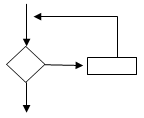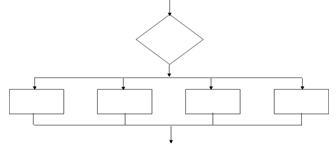This set of Tricky Computer Fundamentals Questions and Answers focuses on “Flowcharting Rules”.
1. A ______________ is diagram that depicts the flow of a program.
a) Algorithm
b) Hash Table
c) Graph
d) Flowchart
View Answer
Explanation: A flowchart is a diagram that helps us determine the flow of the program. Other options are irrelevant.
2. Terminals are represented by diagonals in a flowchart.
a) True
b) False
View Answer
Explanation: The statement is false. Terminals are represented by rounded rectangles. They indicate the starting or ending point in a flowchart.
3. The operation represented by parallelograms.
a) Input/Output
b) Assignment
c) Comparison
d) Conditions
View Answer
Explanation: The input/output operations are represented by parallelograms. They generally are used to display messages during input and output part of a program.
4. Which of the following is not a flowchart structure?
a) Process
b) Sequence
c) Repetition
d) Case
View Answer
Explanation: There are basically four flowcharting structures:
• Decision
• Repetition
• Case
• Sequence.
5. The action performed by a ___________ structure must eventually cause the loop to terminate.
a) sequence
b) case
c) repetition
d) process
View Answer
Explanation: The action performed by a repetition structure must eventually cause the loop to terminate. Otherwise, an infinite loop is created.
6. The following symbol denotes:

a) Module
b) Terminal
c) Process
d) i/o operation
View Answer
Explanation: This symbol is that of a module. The terminal is denoted by a rounded rectangle. I/O operation by a parallelogram and process by a rectangle.
7. What type of structure is this?

a) sequence
b) case
c) repetition
d) process
View Answer
Explanation: This is a repetition structure. The action performed by a repetition structure must eventually cause the loop to terminate. Otherwise, an infinite loop is created.
8. What type of a structure is this?

a) sequence
b) case
c) repetition
d) process
View Answer
Explanation: This is a case structure. Certain cases are given along with a default case in the case structure.
9. A _______ is a connector showing the relationship between the representative shapes.
a) line
b) arrow
c) Process
d) box
View Answer
Explanation: Arrows are the connectors that show the relationship between different shapes. They also show the flow of the program.
10. The following box denotes?

a) Decision
b) Input/Output
c) Process
d) Module
View Answer
Explanation: The answer is decision. Conditions are given in this box and then the result is checked accordingly if the condition is true or false.
Sanfoundry Global Education & Learning Series – Computer Fundamentals.
To practice tricky questions and answers on all areas of Computer Fundamentals, here is complete set of 1000+ Multiple Choice Questions and Answers.
If you find a mistake in question / option / answer, kindly take a screenshot and email to [email protected]
- Check BCA Books
- Apply for BCA Internship
- Practice Computer Science MCQs
- Check Computer Fundamental Books
- Practice Information Technology MCQs
